► Visiting the legendary 25-year old Detroit cruise
► FCA crate motor and Jeep concepts driven
► Check out insane 707bhp Plymouth ‘Hellvedere’
If you’ve visited any form of car-related media over the past few days, you can’t have missed the passing of Monterey Car Week, perhaps the most highfalutin’ celebration of automotive exotica on the planet. But while they were breaking out their blazers and ogling extraordinarily expensive Bugattis and the like in California, over in Detroit we were having a party.
For the third Saturday in August is also traditionally the timing for the Woodward Dream Cruise – and as cultural counterpoints to Pebble Beach go, it’s hard to imagine one much bigger.
If you like Detroit iron in all its guises – or cars of any kind, really – it’s also hard not to get carried away with how awesome it is.
What the hell is the Woodward Dream Cruise?
Celebrating its 25th year in 2019, the Dream Cruise occupies a substantial stretch of Woodward Avenue, which runs through the middle of Detroit and is recognised as the USA’s first highway. Originally, and officially, a day-long event, it now takes over the area for most of the month – and we were spotting muscle cars and hot rods miles from the epicentre for days beforehand.
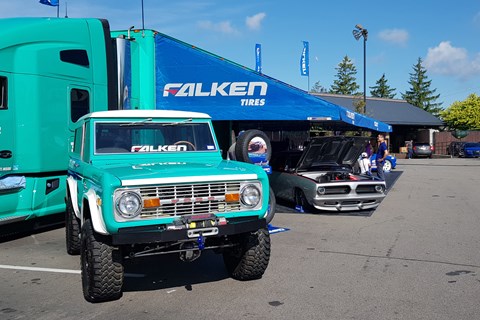
The whole thing started as a charity money-raiser for a football pitch back in 1995 – that’s football as in soccer, rather than the American kind, which makes you feel right at home. Intended to ‘relive and recreate the nostalgic heyday’ of cruising in the 1950s and 60s, the organisers expected to attract around 25,000 people, which even looking backwards seems like an ambitious number.
In fact, an estimated 250,000 people turned up.
These days it’s said to be more like 1.5 million, with some 40,000 vehicles participating – numbers that are hard to credit, but not entirely unbelievable. Woodward is a long piece of road, four lanes to each side, and by midday on Saturday the place is absolutely packed, with cars lining both edges as well as crawling the tarmac.
Is it as mad as it sounds?
To get a feel for the atmosphere, imagine a happening with the accessible spirit of the Goodwood Festival of Speed, populated almost entirely – but not exclusively – by Americana, held on public roads, and not only free to attend but free for anyone to participate in as well. The soundtrack is barely silenced V8, the aroma unfettered exhaust gases, barbeque and summer heat joy.
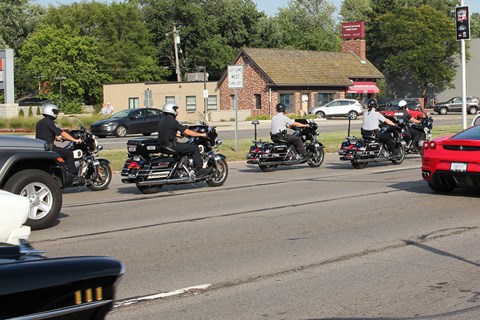
Over the years the cruise has clearly become more commercialised, as enterprising businesses sell admittance to their adjoining parking lots and grass, for example, and for 2019 the main sponsor was Ford. The police presence is also impossible to miss, with regular checkpoints and roving gangs of motorcycle officers galore – long gone are the early days of informal drag racing between stop lights, and the one guy we see get exuberant with a U-turn is immediately ticketed by a passing patrol car.
But the sense of inclusion is outstanding. While the event is undoubtedly a major nostalgia trip for most attendees and a big, big celebration Detroit’s Motor City heritage, you don’t hear anyone complaining about the appearance of modern muscle, the occasional supercar or indeed the Japanese and European models that have boldly snuck in – though these are few and far between.
It is, quite simply, an enormous celebration of car culture in all its forms, with a few motorbikes and bicycles in the mix.
What’s with the Jeeps?
Fiat Chrysler Automobiles (FCA) brought out a bunch of its recent concept cars on the Friday – something it’s never really done at Woodward before. This included a host of Easter Safari Jeeps (some first revealed at the 2018 SEMA show), a pair of Ram pick-ups and a couple of the projects used to demonstrate the potential of its crate engines.
The American arm of FCA treats its ‘concept’ cars a little differently to the ones we’re used to in Europe, in that they’re actually built to be driven, rather than flights of pure fantasy. So this was no exercise in pushing around a styling buck in order to fake drive-by photography – we were let loose onto streets already mobbed with dream cruisers kicking off their Woodward experience a day early.
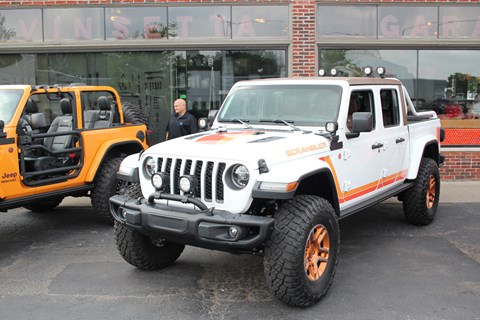
They really work?
The Jeep concepts are largely moving parts catalogues. The three-door and very yellow Wrangler Nacho, the white, retro-graphiced Gladiator Scrambler and the orange, door-free Gladiator Gravity are all based on production platforms, and built-up mostly using the Mopar Jeep Performance Parts any customer can walk into a dealer and purchase.
There are a few prototype elements, but these are mostly cosmetic – the lifted suspension, beadlock wheels with their chunky off-road tyres and the nicely tuned sports exhausts are available to anyone. As are the tube doors, which are an extension of the Wrangler’s long tradition of making the standard ones removable, along with the roof.
The blue Jeep J6 concept is the odd one out, as it’s a two-door pick-up based on the Wrangler four-door’s wheelbase – Jeep’s production Gladiator truck is a four-door with a longer chassis. Assembled from the bones of six different vehicles, the J6 also features a six-foot loadbed in place of the Gladiator’s five-foot item, riffing on the idea of a slightly more practical Jeep ute.
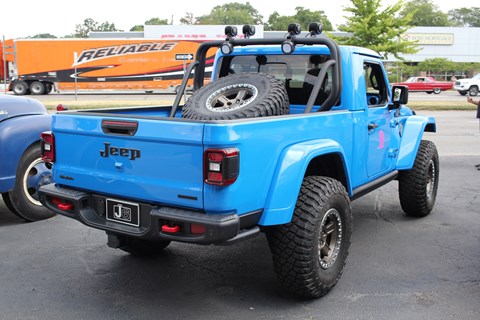
Each of these Jeeps drives and feels like a production vehicle, with plenty of poke from their 3.6-litre 282bhp petrol V6s and a lot of suspension travel. This makes them a touch flighty at highway speeds, but it isn’t exactly an issue under the circumstances. The low speeds enforced by the crowd is a good thing anyway, as it reduces the chances of accidentally rear-ending the vehicle in front when gawping at the de Tomaso Pantera that’s alongside you.
What about the pick-ups?
Both Ram 1500s, these serve to highlight the difference between Mopar’s production engineering and its more conceptual stuff – while the two-tone Low Down is entirely drivable, the two-inch drop in ride height has been done more for static style than handling, and the result is a very bouncy backside that practically pogos through the underpass at the Detroit Zoo crossing.
By contrast, the blue truck features a production lift kit – America’s pick-up market is more interested going up than down at the moment, and there are some extreme versions of this in evidence on Woodward – and drives beautifully, the same underpass enhanced by another tunefully vocal Mopar exhaust.
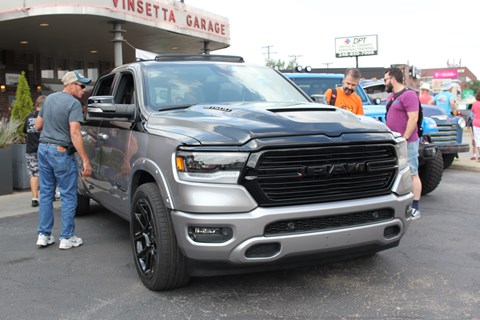
As an aside, both cars are based on the entry-level Big Horn trim level, as Mopar specifically targets those buyers who can’t afford high-spec models but still want to personalise their trucks. From the inside they feel anything but base spec, regardless, with huge amounts of space and a quality feel that’s at odds with typical European clichés about American interiors. Surprisingly appealing.
And the crate engines – what’s that about?
Most American car makers have a sideline selling their high-performance engines so customers can pep-up their own project cars – which is all the excuse Mopar’s engineering and marketing departments need to create the occasional project cars of their own. Hence the Shakedown – a streak of matt-black meanness originally built for SEMA, housing a 485bhp Hemi 392 engine within a subtly updated 1971 Dodge Challenger body.
That body, with smoothed rain rails, shaved door handles and classic shaker hood, is hung on a custom tube frame chassis, and outfitted with lights from a 2017 Challenger front and rear, giving it an appearance that these eyes easily mistake for something much more modern but isn’t fooling any of the observing American muscle car enthusiasts, who clock its heritage and individuality immediately. For the most part they seem to approve.
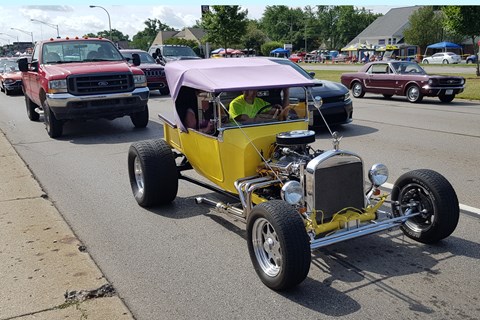
And ye gods, so do we. The engine is all motor – so no turbo or supercharging nonsense here – which means it punches hard right out of the blocks. The manual gearbox, a Tremec T6060 borrowed from a Dodge Viper (which also donated its front seats), is an utter pig at a standstill, taking two hands and a lot of swearing to force into reverse. But once you’re rolling, the super-short, closely spaced six-speed action comes to you like a familiar light switch, and instils what could swiftly become a severe case of over-confidence.
Fortunately, for something essentially knocked up as a mobile advertising platform, and with nearly no genuine road miles prior to this event, the Shakedown is a tautly controlled riot rather than total chaos – and testament to the people that put it together with street driving and racing firmly in mind. Despite 19- and 20-inch wheels, rubber-band tyres and no perceivable gap between the tread and the bodywork, it rides well and handles with sure predictability. The engine is a real heartbreaker, and gladly it stops hard, too, thanks to a set of Dodge Hellcat brakes. After half an hour at the wheel, we want one.
But not quite as much as we want a Plymouth Hellvedere.
What is a Plymouth Hellvedere?
The second crate motor car, making its public debut at Woodward 2019, started life as an innocent 1967 Plymouth Bellvedere II, which was about to be discarded from FCA’s heritage collection in order to make space for something else.
Noting the splendid patina – it’s all original on the outside bar some touch-up paint – Mopar’s engineering team wasn’t about to let that opportunity pass, and scooped it up in order to install a Hellcat crate motor. You’ll have heard of the Hellcat; it has a factory 707hp and 650lb ft. All of which now resides under the bonnet of this late 60s Plymouth.
This is a very different experience to the Shakedown, and not just because of the extra 222hp.
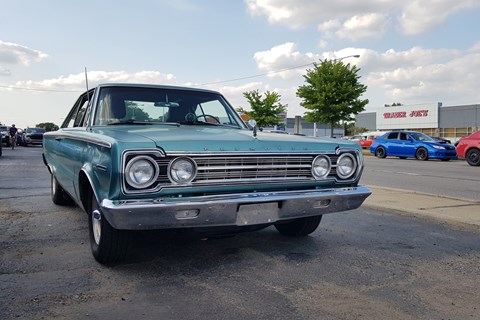
The vast steering wheel is hooked up to a power-steering system that retains true American classic vagueness – meaning you find yourself sawing away at the wheel just to keep on cruising in a straight line. Ahead of you, the needle on the original speedo flickers like a nervous Geiger counter, clearly not at all comfortable communicating with the engine’s modern electronics and leaves you with only the rate you’re passing other traffic as a guide to how fast you’re actually going.
Well, that and the noise from the exhaust, which the Hellvedere’s slightly nervous-looking chaperone wryly suggests could do with ‘a little more tuning’. Exiting just ahead of each rear wheel, if there’s any silencing at all it’s in hiding – it’s not often you get to use the phrase ‘rolling thunder’ and not feel totally stupid about it, but the tearing sound this monster makes ripping through the nearby underpass is so loud it’s a wonder the police don’t send a helicopter. And a SWAT team.
Steering aside, this is another inspiring piece of custom car building. A set of modern disc brakes assures you it will stop, the ‘heavy-duty’ Tremec Magnum six-speed manual transmission is fantastically positive, and the combination of a National Hot Rod Association approved rollcage with hidden chassis strengthening stops the car flexing to bits whenever you lean on the drive-by-wire throttle (an essential part of the crate kit).
As an introduction to the retro-modern art of American muscle, it’s a mainline to addiction. Better to stop driving before the pre-return-flight shopping effort includes a very large box and a lot of spanners.
So Woodward is one for the bucket list, right?
If you like cars and can make it out there, it’s a must-see. Do not pass go, dive directly into your overdraft. And even knowing the scale of the Woodward Dream Cruise ahead of time is unlikely to prepare you for the incredible scope of the experience.
At the whacky end we saw hot-rod shopping trolleys and mobile picnic benches; there were privately owned military vehicles – some of which dwarfed the occasional Humvee – classic Ferraris, modern Lambos and McLarens, and just the most astonishing array and variety of Americana, and thanks to the culture of customisation you’ll be hard-pressed to spot two cars that are exactly the same.
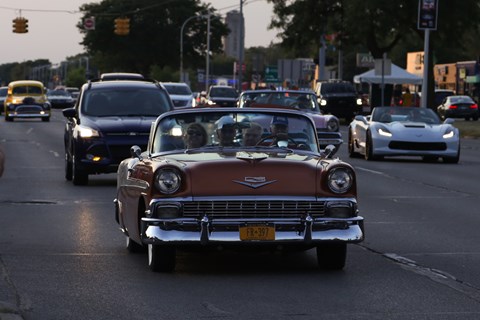
You’ll find yourself laughing along with the old geezers, sat in lawn chairs and wielding table tennis bats adorned with slogans deployed to judge the passing vehicles (‘nice car’ versus ‘nice dog’), and be staggered that not only do the drivers of those cars slow or stop if they see you trying to take a photograph but that the buses will pause to make sure you capture that shot of the classic Corvette in the middle lane, or the Delorean driving along with its doors up.
Never mind California dreaming at Monterey, this writer will now forever be cruising in Detroit. What an amazing celebration.
Check out more Car Culture features here